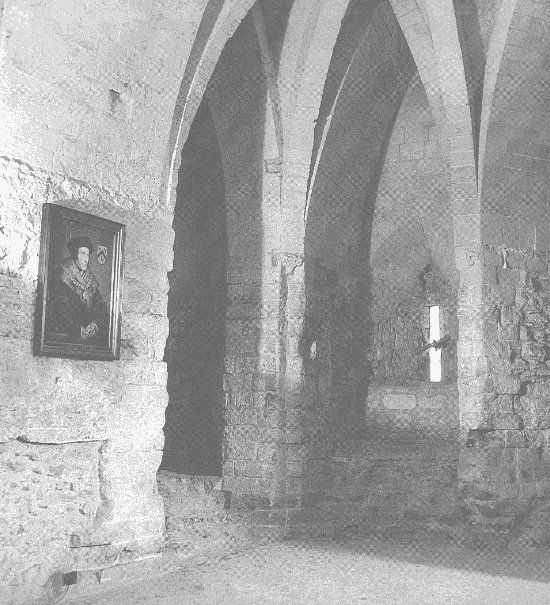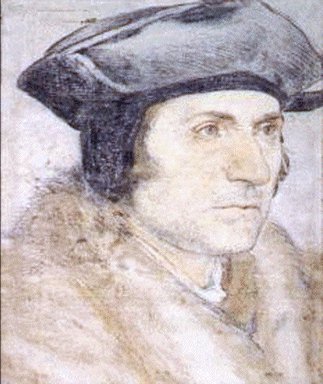
"I die the king's good servant, and God's first."--Thomas More
"Blessed Thomas Moore is more important at this moment than at any moment since his death, even perhaps the great moment of his dying; but he is not quite so important as he will be in about a hundred years' time. He may come to be counted the greatest Englishman, or at least the greatest historical character in English history. For he was above all things historic; he represented at once a type, a turning point and an ultimate destiny. If there had not happened to be that particular man at that particular moment, the whole of history would have been different."
--G. K. Chesterson, "A Turning Point in History"
There is much to learn from the story of how the head of one of the most revered men in England, Sir Thomas More, ended up on the chopping block on London's Tower Hill in 1535. Few people in history have faced their trials and deaths as squarely, calmly, and with as much integrity as did More.
More's road from his post as Lord Chancellor of England to the Tower of London owes its course to a Bible passage, a marriage of a long-dead prince, and the consuming desire of lustful and vain-glorious King Henry VIII to marry Anne Boleyn. Swept along with More, in this fateful confluence of writings, events, and people, was nothing less than the Reformation.
Henry Finds Leviticus
In 1509, when the new eighteen-year-old King, Henry VIII, married a young Spanish princess, Catherine of Aragon, the marriage came with the blessing of Pope Julius II, in the form of a dispensation from an injunction found in the Bible's Leviticus. The dispensation was deemed necessary because Catherine had been briefly married to Henry's older brother, Arthur, raising the question of whether Henry's marriage violated Leviticus 20:21: "If a man shall take his brother's wife, it is an unclean thing...they shall be childless." The fact that Arthur remained ill throughout the six-month-long marriage until his death, and that therefore the marriage--if Catherine is to be believed--was never consummated, doubtless made the case an easier one for Pope Julius than it otherwise might have been.
Seventeen years passed without questions being raised about the Pope's dispensation. But then in early 1526, however, King Henry's affection turned from Catherine to the beautiful Anne Boleyn. Reviewing Leviticus, Henry began to question the lawfulness of his marriage to Catherine. Even the least skeptical historian, of course, has considered the possibility that lust, together with a desire to father the healthy son that Catherine--now past her child-bearing years--could not, might have influenced his interpretation of the Bible chapter. Whether out of concern for his soul or for his sex life, Henry set in motion a process that would change the face of Europe.
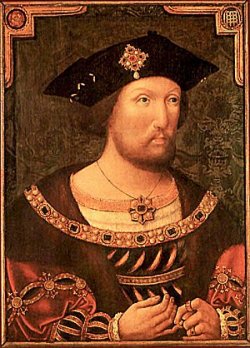
Henry VIII
In early 1527, Henry instructed his Lord Chancellor, Cardinal Thomas Wolsey, to institute proceedings to resolve the issue of the validity of his marriage to Catherine. Henry's request came at a tumultuous time in European history. Emperor Charles V pushed his troops toward Rome and, in May, wreaked havoc in the city. Troops raped women, killed children, and even disentombed the corpse of Pope Julius II and dragged it through the streets. (The living pope, Pope Clement VII, fled Rome for a castle in St. Angelo, where he was held prisoner--complicating Wolsey's task of gaining a dispensation for Henry). Meanwhile, in an effort to counterbalance Charles's power, Sir Thomas More, a loyal councilor of Henry's, working in France, successfully negotiated a treaty between England and its longtime enemy.
By June, Henry had become sufficiently convinced that his 1509 marriage violated the command of Leviticus and he informed his wife that they had been unlawfully married for the past eighteen years. Faced with having her dignity as a married woman stripped and her surviving daughter labeled illegitimate, Catherine did not take the news well.
When More and Wolsey returned to England in September, after traveling to France to ratify the new treaty, the King raised with More at Hampton Court the issue of his marriage. According to More, "his Highnes walkying in the galery, brake with me of his great mater." More reported that Henry "layed the Bible open byfore me, and ther red the wordis that moved" him to conclude his marriage was unlawful. When More suggested a different interpretation of Leviticus, the King ordered him to "commune ferther" with royal advisers and read a report--then in preparation--that made the case for annulment.
Later in the fall, Henry took the unusual step of visiting More at his home in Chelsea to take up again his "great matter." In a scene memorialized in Robert Bolt's great play, A Man for All Seasons, the King walked the gardens with his arm around the neck of his trusted councilor. Henry and More differed, in the end, over the matter of papal supremacy. The King argued that Leviticus made his marriage a crime in God's eyes--and that no Pope had the power to waive the Biblical injunction. More, on the other hand, accepted papal supremacy as a matter of faith, and tended to view Pope Julius's 1509 dispensation as conclusive. More represented tradition. He was the staunch defender of the faith in a Europe where the Catholic Church was under increasing attack. More took his stand only a decade after Martin Luther had declared the Pope to be "the Antichrist," leading to Luther's excommunication and trial. While More and Henry debated the Pope's power, most of northern Germany was in the process of turning Lutheran. Powerful historical currents were in play.
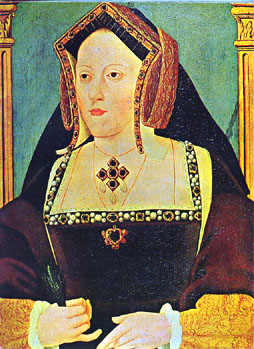
Catherine of Aragon
From Henry's standpoint, the proceedings to gain the annulment of his marriage to Catherine continued at a frustratingly slow speed and with no tangible results. In the summer of 1528, as London confronted outbreaks of the plague and sweating sickness, the Pope dispatched Cardinal Campeggio from Rome to convene a legatine court in London that would decide the matter. For his part, Thomas More occupied himself aggressively pursuing heretics, who he viewed as a much greater threat to England's well-being than the King's marriage controversy.
On May 31, 1529, at the Dominican house of Blackfriars in London, an inquest into the King's "great matter" convened. Three weeks later, on Midsummer's Day, a remarkable scene took place--one that is slightly recast in Shakespeare's King Henry VIII. In the real event, the proceeding opens with the cry, "King Harry of England, come into the court!" "Here, my lords," the King replies. "Catherine, Queen of England, come into the court!" Without an answer, Catherine walked over to the King, then knelt and pleaded for "pity and compassion." She proclaimed her loyalty to Henry and insisted that she never had relations with her husband's brother. Henry, in response, stated that were it not for his love for her, he would have acted sooner on his religious doubts--and pledged to abide by the court's conclusions concerning the lawfulness of his marriage. In a speech that followed, Henry made the case for annulment and acknowledged--at Wolsey's request--that he, and not any member of the clergy, was the "chief mover" of the inquest. In a moment of drama that portended another date with the executioner's block, John Fisher, the Bishop of Rochester and a main supporter of Catherine, rose to make clear that he had not, as the King had implied, joined with other bishops in signing a document urging the King to take the matter of his marriage to the Pope. The inquest produced no results; Catherine chose to make no more appearances, nor to recognize its authority to decide the validity of her marriage. Instead, in July, she appealed the matter directly to Pope Clement--who then announced that the decision would be made in Rome, not England.
While the court at Blackfriars continued in session, Thomas More traveled to Cabrai, where negotiations involving major European powers to take place. More played England's cards well, winning separate peace agreements with Francis and Charles V. The agreements, which would hold the peace in Europe for fifteen years, rank among More's proudest achievements. More chose to remember the accomplishment on his tombstone at Chelsea along with just one other: he noted that he had always been "molestus" (troublesome) to heretics.
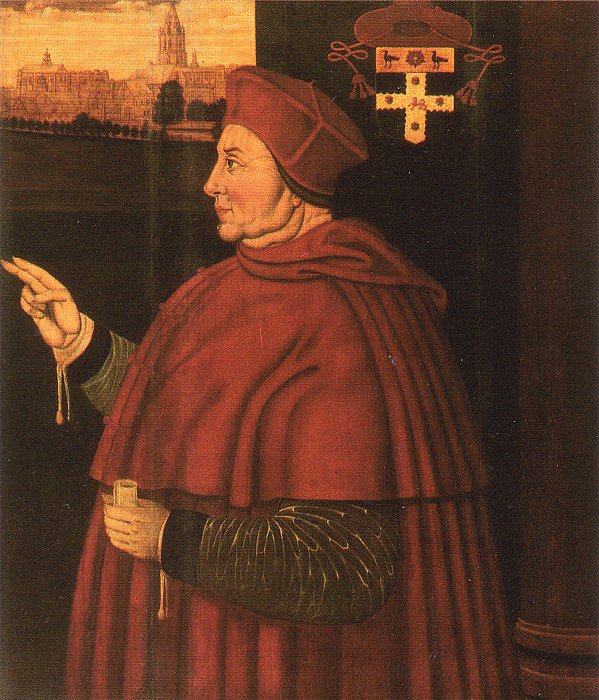
Cardinal Wolsey
The failure of Cardinal Wolsey to secure a Church decision annulling his marriage did not sit well with King Henry. In October 1529, Henry ordered Wolsey arrested for treason and stripped him of the title of Lord Chancellor, the highest appointed office in England and a position he had held for fourteen years. In his place, Henry chose Thomas More. The choice was widely acclaimed. Wolsey called his replacement "the aptest and fittest man in the Realm." More, despite having sympathies for Catherine and being well aware of the tension that might cause, accepted the post--primarily because it offered him an opportunity to defend his Church against what he saw as a growing plague of heretics. (During his tenure, More would ban heretical texts, search the home of heretics, and prosecute--and even burn--those persons he believed to be undermining Church authority.)
The King Takes on the Church
Beginning in 1530, King Henry VIII took an increasingly aggressive posture on the matter of his marriage annulment. Thomas Cranmer, who would become a sort of scholar-in-residence for Henry, wrote a treatise, Collectanea satis copiosa, that demonstrated the unlawfulness of the marriage between Henry and Catherine. The King added his own handwritten comments in the margins. The report circulated to faculties of England's universities which duly--under some pressure--issued declarations that the King's scruples were probably justified.
In the middle of June, Henry convened a meeting of lords and prelates, who were persuaded to send a letter to Pope Clement asking that the King's annulment be granted. More's signature was conspicuously absent from the letter sent to the Pope. In the month after the meeting, the King's attorney general charged fourteen prelates (including Bishop John Fisher) who had sided with Catherine in the dispute with violations of praemunire laws. Clement's answer to the King's letter could not have made Henry happy; the Pope reminded the King that his refusal to send a delegate to Rome was the principal cause of the delay in resolving his "great matter."
In September, Henry issued a proclamation that prevented enforcement of any papal bull inconsistent with his own view of his marriage's lawfulness. Henry's direct attack on Vatican authority upset Thomas More, who openly expressed his disagreement with the King's action.
The King's movement away from Rome continued. Intellectual support for the move came in the form of an influential argument by a lawyer, Christopher St. German, who wrote that the law of the realm should trump ecclesiastical law. In November 1530, a man who would become an eager proponent of the St. German's view, Thomas Cromwell , became a member of the King's inner council. In time, Cromwell--cunning, cynical, intelligent, ambitious, resourceful--would prove to be More's chief nemesis. (A case could be made for Cromwell. His efforts prevented mass bloodshed in England and his pragmatic nationalistic politics seem a better fit for the time than More's campaign to preserve the medieval order. By insisting that English law was supreme to what More called "God's law," Cromwell helped pave the way for an England that could chart its own destiny. In the process, he also eliminated Rome's annoying drain on England's economy.)
Henry's impatience became obvious in 1531. The angry King summoned the clergy to Westminster, where he demanded that they reimburse the Crown for the costs of sending a delegation to Rome on a failed mission to secure his annulment. But his demands did not stop there. He insisted that the convocation issue a statement recognizing him as "the sole protector and supreme head of the English Church and clergy." After a heated debate--and insertion of the phrase "so far as the law of Christ allows"--the bishops agreed to issue the statement of recognition.
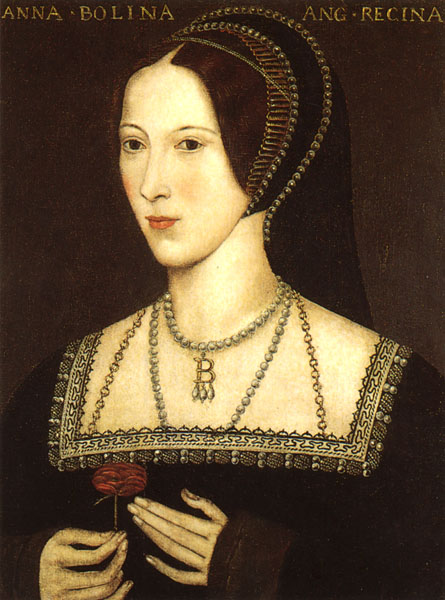
Anne Bolelyn
While a formal decision on his marriage hung in the balance, Henry took direct action. In May, at his request, a group of royal councilors met with Catherine and urged her to drop her opposition to the annulment. The mission failed. Henry, however, had waited long enough. On July 11, 1531, Henry and Catherine separated. By late the following year, Anne Boleyn was pregnant and, in early 1533, Henry and Anne Boleyn secretly married.
While the King and Anne Boleyn shared a bed, Henry's advisers stepped up pressure on Rome and domestic opponents of his annulment. In 1532, Thomas Cromwell presented a bill to Parliament that denied payment to Rome (in the form of "annates" that had been levied on every diocese in return for Papal consecration of new bishops) and moved to limit the authority of the Church--and Thomas More--to punish heretics. A bill prepared for the King by Cromwell transferred powers of the Church to Parliament and denied to bishops their longstanding authority to arrest heretics.
Thomas More could not stomach the assault on his authority to continue his pursuit of heretics. The last straw, for the Lord Chancellor of the Realm, turned out to be the decision on May 15 of the English clergy, submitting to Henry's demand, to accept that all ecclesiastical law required royal consent--an action that effectively made Henry the head of the Church of England. On the next day, More submitted his resignation. In the garden of Westminster's York Place, More handed Henry the great seal, concealed in a white leather pouch, and bowed. Henry accepting the seal, told More, "For your service you have done me, you will find me a good and gracious lord." The two men would never meet again.
In April 1533, Parliament officially declared Henry's marriage to Catherine to have been invalid and Anne Boleyn proclaimed "Queene at Greenewych." The coronation was a grand affair at Westminster Abbey. Thomas More, still serving as a King's councilor even though no longer Lord Chancellor, did not attend the event, angering Henry. It was at this moment, says More biographer Peter Ackroyd, that "Henry hardened his heart" against More. Henry now had no greater thorn in his side that More. Henry determined to remove More's stubborn opposition--one way or another.
The Arrest and Imprisonment of Thomas More
In the summer of 1533, Master Secretary Thomas Cromwell began an investigation into the activities of Thomas More. More's former position and his wide respect made him easily the most prominent of the opponents to major portions of the King's agenda. One aspect of Cromwell's investigation focused on More's relationship to Elizabeth Barton, a nun who claimed to have experienced visions about a dire future for England should Henry follow through on his plans to marry Anne Boleyn. More had met with Barton to discuss her visions, and the King's men were aware of their association. A proposed bill of attainder drafted by Cromwell identified More as an accomplice of Barton. On the scaffold after conviction for treason, Barton confessed that her revelations were fraudulent, providing additional ammunition for those who would like to use her guilt to tar More.
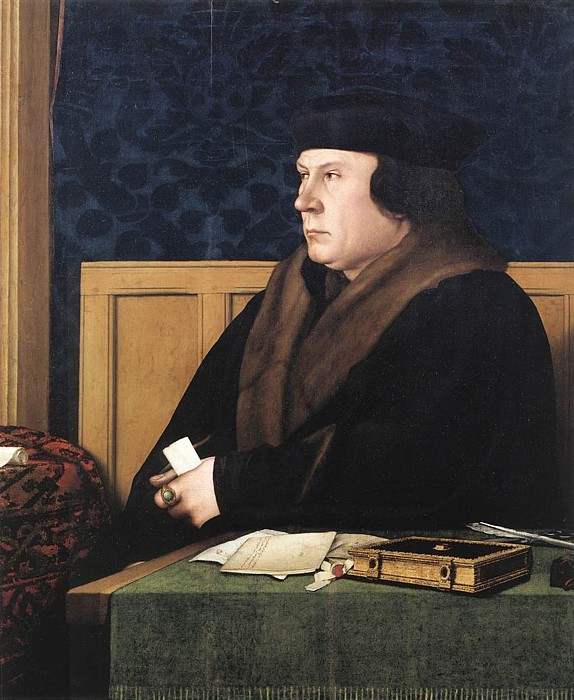
Thomas Cromwell
More denied any conspiracy with Barton in an informal meeting with Cromwell in February 1534. A month later, in letters to both Henry VIII and Cromwell, More reaffirmed his loyalty to the King and his desire to see the King's interests furthered. On the matter of Henry's marriage, More adhered to a policy of silence. He continued to affirm his belief in papal supremacy, but was careful to do so by suggesting that his belief was based on the persuasive power of an earlier writing on the subject written by the King himself. More's caution, however, did not prevent the pressure against him from increasing. Commissioners of the King summoned More to a meeting in which they threatened him and called him "a villainous servant," but departed without taking action.
Meanwhile, Parliament, sitting in an extraordinarily long session, enacted numerous bills proposed by Cromwell on the King's behalf. The Act of Annates provided that bishops in England would be selected by the King, not Rome. The Act of Succession declared Henry's marriage to Catherine void and established a line of succession through the children of Queen Anne. The Act also specified various new offenses to be treasonous, such as "derogating" the royal family. Most significantly for Thomas More, the Act required all of the King's subjects to take an oath promising to maintain "the whole effects and contents of the present Act."
On April 12, 1534, soon after leaving church at St. Paul's Cathedral with his son-in-law William Roper, More was handed a summons to appear at Lambeth Palace the next day to take the oath of succession. More returned to Chelsea to spend with his family what he probably knew would be his last night as free man.
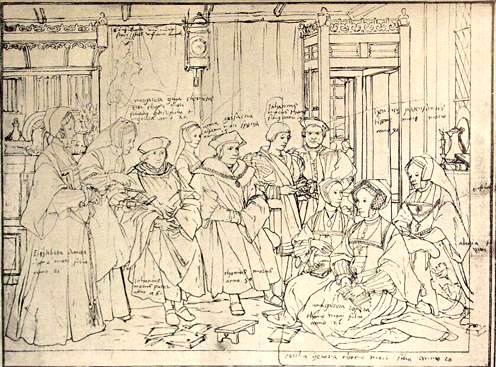
Sketch of the family of Thomas More (Holbein)
The next morning, More bid farewell to his family at the front gate, and boarded a boat for Lambeth with Roper and four servants. As they set off down the river, More--at peace with his decision--tells his son-in-law, "Son Roper, I thank our Lord the field is won."
When asked to take the oath at Lambeth Palace, More asked to see the texts of both the oath and the Act of Succession. After reading the documents, More told the commissioners that while he would deny nothing contained in the oath, his conscience would not allow him to take it. Indecisive as to how to handle More's refusal, the commissioners sent More out to a room adjoining the Palace's garden to wait while they discussed the matter. Summoned back, More refused for a second time--even after much cajoling and threats of imprisonment--to take the oath. He also refused to elaborate further on his reasons. The frustrated commissioners turned More over to the Abbot of Westminster, who kept him for four days before he was transferred to a cell in the Tower of London.
More spent the remainder of the year in the so-called "Bell Tower." He used the time in his dimly lit cell to write a lengthy book called A Dialogue of Comfort Against Tribulation. He also wrote letters to his beloved daughter, Margaret, comforting her and offering what explanation he could for the decision that led to his imprisonment.
The Trial of Thomas More for Treason
In November 1534, bills were introduced in Parliament that would eventually lead to More's trial and execution. The Act of Supremacy, the law enacted in 1535 declared Henry to be the supreme head of the Church of England (formalizing the clergy's earlier submission to this authority). The Treason Act made it a capital offense to maliciously wish, will, or desire, by words or writing" to deny to members of the royal family their "dignity, title, or name of their royal estates."
Photograph of More's cell in the Tower of London
After enactment of the new laws, Thomas Cromwell and four other advisers to the King interviewed Thomas More in a room at the Tower of London. The men told More that Henry demanded to know More's opinion of the Act of Supremacy. More balked at the request, saying that he refused to "meddle" in such affairs. Told that the King might yet be merciful if More acknowledged his consent to the Act, the prisoner was unmoved. My whole concern now, More told the men, was to live the best possible Christian life.
In May 1535, King Henry's determination to crush his remaining opposition hardened. Within days after the King learned that the Pope--who had condemned Henry's marriage to Anne and threatened him with ex-communication if he did not return to Catherine--had made Bishop Fisher, the most outspoken supporter of Catherine in England, a cardinal, the King's men brought charges of treason against Fisher. As wryly noted by historians, Fisher's head was off before his cardinal's hat was on.
More faced intense questioning in a third interrogation before Cromwell and other councilors. Asked once again to give an oath--this time an oath to the supremacy of Henry as the head of the Church of England--, More retained his resolute silence. Stepping up the pressure, authorities sent Solicitor-General Richard Rich to More's cell with instructions to remove his books and writing materials. (While Rich and More visited briefly in the Tower, a discussion about the King's role might--or might not have--taken place. The question of what really happened would become a focus of More's later trial.) Shortly after Rich's visit, More faced official investigators again in what amounted to a preliminary hearing to determine whether he violated the Treason Act.
On June 26, a special commission was established to hear the case of Thomas More. Two days later, a four-count indictment charging More with treason was presented to the commission. More would stand trial for his life.
The trial of Sir Thomas More for treason opened in Westminster Hall on July 1, 1535. Although a jury of twelve men would have the final say, More had to understand that a verdict of guilty was inevitable. Were the jury to have declared otherwise, they might well have faced imprisonment themselves. Reports described More as "weakened by his imprisonment," but having "a cheerful and composed countenance."
The attorney general opened the proceedings by reading the indictment, which consisted of four basic charges. The Duke of Norfolk then offered More a final chance to escape with his life: "You see now how grievously you have offended his Majesty; yet he is so very merciful that if you will lay aside your obstinacy, and change your opinion, we hope you may obtain pardon and favor in his sight." More replied--"stoutly," according to reports--that he appreciated the offer, "but I beseech Almighty God that I may continue in the mind I am in, through his grace, unto death."
Seated in a chair because of his weakness, More attempted to answer each of the charges against him. On the charge of opposing the Henry's marriage, More freely admitted that he had, "according to the dictates of my conscience," told the King his true opinion. To do otherwise, he said, would have "basely flattered" his Majesty and made him "a wicked subject" and "a traitor to God." Giving the King an honest answer, when asked for it, can hardly be treasonous, More contended.
On the second charge of not swearing to recognize the King as the supreme head of the Church when asked about the matter during his Tower interview, that "no law in the world can punish any man for his silence." When told that his silence was "an evident sign of the malice of his heart," More quoted a legal maxim that held that "he that holds his peace, gives consent."
The third charge against More was that, while in the Tower, he wrote letters to Bishop Fisher inciting him to violate the Treason Act. The letters in question, which authorities claimed Fisher burned, could not be produced. More insisted that the letters counseled no violations of law. The letters, he said, merely told Fisher that he had followed his conscience when questioned on the matter of Henry's supremacy of the Church, and that Fisher should "satisfy his own mind"--whatever position that took him to.
The fourth charge, described by More as "the principal crime objected against me," concerned his Bell Tower conversation with Richard Rich a few days before. The indictment alleged that More, responding to a hypothetical question posed by Rich, told his visitor that the Parliament had no more power to enact the Act of Supremacy that it did to pass a law declaring God not to be God. The court called Rich to testify, and the solicitor-general gave his account of the conversation, confirming the charge laid out in the indictment. More emphatically rejected Rich's testimony, saying that if Rich's version were in fact true "then I pray I may never see God's face." More's striking statement, given his intense and sincere religiosity, leaves little room to doubt but that Rich was flat-out lying. More added that he was "more concerned about Rich's perjury" than he was about his own "danger." He said that he had long regarded Rich as a liar, "a great gamester, and of no good name and character." How likely was it, More asked his accusers, that he would choose, among all the people of the Realm, Richard Rich to confide "the secrets of my conscience?" More's powerful answer to Rich's accusation prompted the attorney general to call to other men who were present in More's cell at the time of the supposed conversation to testify. Although neither men would likely risk the King's ire that might come if they supported More's account, they did him the next best favor and testified that they were too busy stuffing More's books and carting them away to have paid any attention to the conversation between Rich and the prisoner.
The jury deliberated for "scarcely a quarter of an hour" before returning with its verdict: Guilty. As the Lord Chancellor began to pronounce sentence, More interrupted to remind him it was customary to allow defendants to speak prior to the imposition of sentence. More, finally with nothing more to lose and free to speak his mind, told the court his indictment was grounded on a law "repugnant to God." Further unburdening himself, More said that the Parliament lacked authority to enact any law inconsistent with the teachings of "Christ's universal Catholic Church." He added that he thought the recently enacted laws also violated the Magna Charta and the King's Coronation Oath. The Lord Chancellor broke in to ask More how he reconciled his opinion with the fact that "all the bishops, universities, and most learned men of the Kingdom" found the Act lawful. More responded that if one were to take account of the views of all of Christendom, and not just England, his view would be favored by "ten to one."
Finally, sentence was pronounced on the man of unbreakable conscience: More should be "drawn on a hurdle through the City of London to Tyburn, there to be hanged till he should be half dead; then he should be cut down alive, his privy parts cut off, his belly ripped, his bowels burnt, his four quarters sit up over four gates of the City and his head upon London Bridge."
After the reading of his sentence, the constable escorted More to an awaiting barge, which carried him the short ways down the Thames toward the Tower of London. The party disembarked the barge at Old Swan Stairs. An armed guard led More, dressed in a coarse woolen gown, up Old Swan Lane and down Thames Street. As More and his guards approached the Tower, his daughter Margaret knelt to receive his blessing, then embraced and kissed him. More then was escorted through the large crowd back to his cell, where he would spend the last six days of his life.
Execution
More spent most of his final days fasting and praying. His famous wit stayed with him until the end. More declined an opportunity for a haircut, telling the barber, "The King has taken out a suit on my head and until the matter is resolved I shall spend no further cost upon it." On the Monday following his sentence, More received a visit from his wife Alice, to whom he gave a final letter for Margaret composed with charcoal. At some point, although it is not known when, More learned that the King had commuted his sentence from disembowelment to beheading--in recognition of More's years of service, it was said.
Sir Thomas Pope, a representative of the King's council arrived in More's cell at dawn on Tuesday, July 6, 1535. The representative told More that he must die at nine o'clock that morning and that the King had requested that he keep his words to a minimum at the execution. Shortly before nine, dressed in a plain gray robe and carrying on red wooden cross, the bearded More was led out of his cell for the 200-yard journey to the execution site on Tower Hill. More's family was not among the crowd; the King had not granted them permission to attend.
An officer steadied More as he climbed to the execution block. Following the wishes of the King, More spoke only briefly to the large crowd that had gathered to watch the event. He told the bystanders to pray for him in this world, and that he would pray for them in the next. He told the crowd, "I die the King's good servant, and God's first." He knelt down in front of the block and uttered the words of Psalm 51. Then he rose and kissed his red-robed executioner. "Be not afraid to do thine office," he said.

Execution block used at Tower Hill
More knelt down, laid his head upon the block, and stretched his arms out in front of him. One blow of the execution's axe took off his head. The executioner raised the head for the crowd to see: "Behold the head of a traitor!" More's head was boiled, impaled on a pole, and positioned on London Bridge.
Epilogue
Thomas More's heroic efforts to preserve the unity of the Church ultimately failed. In the year after his death, Henry VIII escalated his attacks on Catholic institutions, draining monasteries of resources necessary for their survival. Church ornaments, vestments, and jewelled relics were pillaged. Altars and stain-glass windows destroyed, the painted walls of churches defaced. The attack on the Catholic Church in England did not end overnight. Forty years after More's death, the rout would be complete. Europe became a religiously divided continent. Today, Europe's religiosity continues its long and steady decline--a decline that began in the days of More.
Thomas More was a great person and played his role throughout the trial to perfection. This was never a trial More could have won, and he knew that. The trial pf More marked the end of one age in England and the beginning of a new, more dynamic period in its history--its rise to world prominence.
The Catholic Church, however, recognized the More's contributions to the faith. On May 19, 1935, at St. Peter's Basilica in Rome, Pope Pius XI presided at a canonization ceremony for Thomas More and Bishop John Fisher. The Pope said of More:
[W]hen he saw the doctrines of the Church were gravely endangered, he knew how to despise resolutely the flattery of human respect, how to resist, in accordance with his duty, the supreme head of the State when there was question of things commanded by God and the Church...It was for these motives that he was imprisoned, nor could the tears of his wife and children make him swerve from the path of truth and virtue. In that terrible hour of trial, he raised his eyes to heaven, and proved himself a bright example of Christian fortitude.
More biographer Richard Marius reminds us why the life and death of Sir Thomas More remains relevant today. More, he wrote, is that rare and "magnificent individual whose life summarized an age in a way that few lives have been able to do."

